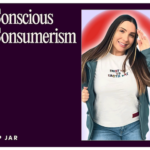Sabrina Pare
Content Creator
-
Tip Jar

Capitalism (didn’t) really pop off today, ladies. But the underconsumption core trend did. Thanks to TikTok and content creators like Sabrina Pare (she/her), the latest hashtag actually has a valuable lesson behind it. “I love this trend,” Sabrina says. “This is typically the type of content I post, so I love to see how widespread it has become and how many people are participating. My content is all about sustainability, and that’s one of the biggest reasons I buy less and upcycle the items I can. I think it’s starting a lot of important conversations about the excessive consumerism in our society and the environmental and financial impacts of it.”
Here, everyone’s sustainable big sis shares what exactly underconsumption core entails, the financial impacts it has, and how you can try it out ASAP.
As someone who’s participated in the trend, can you explain what it is?
I describe it as people going against the typical overconsumption and excessive consumerism we see online. Instead of showing the next trendy item, people are showing items that might not be the newest or in the best condition, but still work. They are also showing items they have upcycled, ways they reduce waste, and things that have gotten secondhand. It’s all about extending the life of your items, reducing the number of items you own, and being mindful of your purchases.
How is it rooted in financial responsibility and sustainability?
Underconsumption core promotes saving money and being more sustainable because it’s all about buying less. Many people buy things for fulfillment, but those feelings don’t tend to last long, so then they buy something again, and it’s a vicious endless cycle of consumption. It shows the benefits of saving money by spending less on unnecessary items and focusing on experiences and savings.
Everything we buy uses up Earth’s resources—from the materials and energy to the water needed to make it. The more we buy, the more we drain our world. That’s why cutting back on shopping is one of the best things we can do for the environment. It saves resources, reduces waste, and helps protect the planet.
What are the benefits?
It’s more sustainable as people are extending the life of their items, reducing their waste, repairing, and upcycling. It promotes minimalism, which advocates for reducing the number of possessions and only keeping what is truly necessary and meaningful, resulting in less clutter. It encourages you to save your money. It advocates for being yourself, and not worrying about participating in all the ongoing microtrends.
How can we participate in underconsumption?
A few things you could do are:
1. Use up what you have first before buying new! Ex: Things like skincare and makeup.
2. Use reusable items instead of single use. Ex: Ditch the paper towels and just use rags to clean.
3. Attempt to repair items when they break. Ex: Sewing a shirt with holes.
4. Find creative ways to upcycle. Ex: Reusing candle jars for storage.
5. Take care of your items so they last! Ex: Washing clothing correctly and/or air drying.



